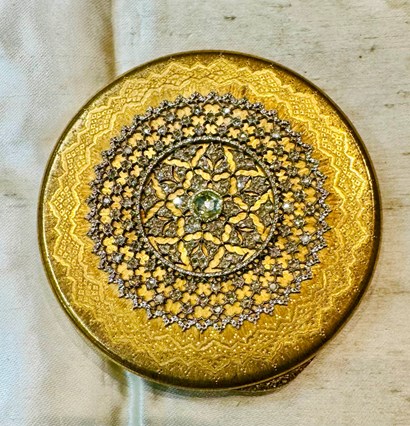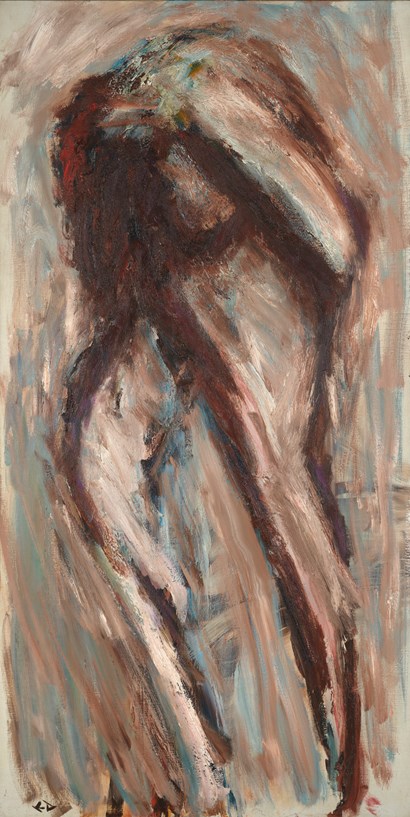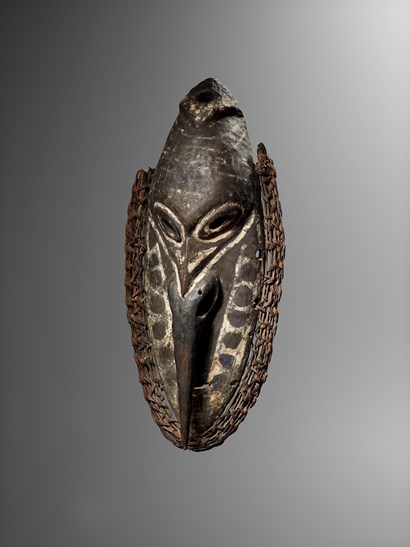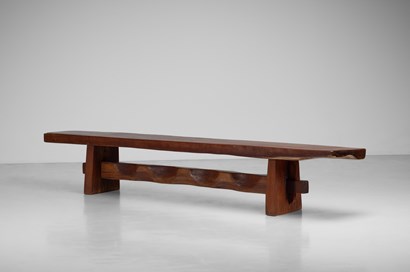This section will be available this Autumn.
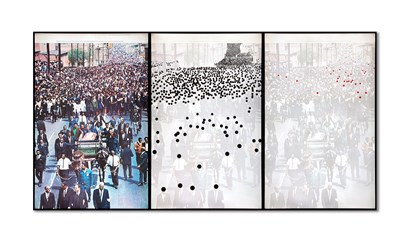
Galerie La Patinoire Royale Bach
alfredo jaar
Alfredo Jaar (Chili, Santiago 1956) Life Magazine, 19 April 1968 1995 Three lightboxes, analog C-print on Duratrans 183 x 360 cm (entire dimension) 183 x 120 cm (one lightbox) Unique piece Life Magazine, 19 April 1968 (1995) by Alfredo Jaar is one of the Chilean artist’s iconic lightbox works in which he pointillistically engages an image from the public archive, intervening with his signature cutting precision to highlight social inequities and the politics of image making. The source image for this work is a documentary photograph of Martin Luther King’s funeral printed in 1968 in Life Magazine, the magazine of reference for a generation of Americans. In the image, a horse drawn casket is surrounded by supporters, and behind, a crowd fills the boulevard, stretching into the vanishing point beyond. It is a powerful representation of the late civil rights leader’s influence. The source photograph is presented large scale on the left third of the lightbox. In the center, the image is whited over, and in the place of faces in the crowd are black dots, massing and overflowing the street. In the rightmost part of the triptych, the source image is similarly whited out, but this time only a smattering of red dots appear — a handful scattered across the crowd. The artist placed black dots on the faces of African Americans. The red dots highlight White attendees. Created while Jaar was researching the Life archives for another iconic lightbox work, Searching for Africa in Life (1996), in which the artist reprints every cover of the magazine, highlighting through the punctum of the title the glaring absence of adequate representation of the continent, Life Magazine, 19 April 1968 (1995) similarly makes manifest a glaring absence. Through the precision of the artist’s intervention, and rendered in the artist’s signature clean lines, a singular gesture evokes the imbroglia of lingering racism and inequality in contemporary society.

Van Pruissen Asian Art
nagai ikka
Nagai Ikka (Japan, 1869–1940) Pair of six-panel folding screens with crows, 1930s Ink on paper H 137 x W 268 cm (each) Signed in the bottom corner Provenance: private collection, Japan Nagai Ikka (also known by the art names Zuiunan and Hanpo) was born in 1869 in Suibara, Niigata Prefecture, during the early Meiji period. He trained under leading masters of the Maruyama and Shijō schools, including Suzuki Shōnen, Nakano Kimei, and Hirafuku Hoan, and later absorbed stylistic influences from Kawanabe Kyōsai. This grounding in careful observation and naturalistic rendering provided the foundation for a personal style that balanced precision with expressive freedom. He began painting crow paintings after helping Ernest Francisco Fenollosa create 'One Hundred Crows', a painting he had commissioned from Kyosai. The late Meiji and Taishō periods were marked by profound change in Japanese art, as artists navigated between traditional aesthetics and the growing influence of Western naturalism. Ikka embraced this dialogue, drawing on classical ink painting techniques whilst expanding his horizons abroad. From 1903 to 1908, he lived in the United States, exhibiting at international events such as the Portland Expo, where he won a silver medal, and later at the Italian Expo. His crow paintings, admired both in Japan and overseas, earned him the affectionate nickname 'Doctor of Crows' from statesman Ōkuma Shigenobu. The crow (karasu) has a long symbolic tradition in Japanese culture, appearing in classical poetry, Buddhist imagery, and Shintō cosmology, most famously as Yatagarasu, the mythical three-legged crow. Ikka revitalised this motif, transforming it from a minor decorative element into the central subject of bold, dynamic compositions. This pair of six-panel folding screens demonstrates his command of movement and atmosphere. Painted in ink with sparing touches of colour, the crows appear in varied postures—perched, in flight, or interacting—creating a rhythm that guides the viewer’s eye across the expansive surface. Bold, calligraphic brushstrokes define wings and feathers, while softer washes evoke wind, mist, and shifting light. The result is a scene that is both naturalistic and poetic, combining the restraint of traditional ink painting with a striking modern vitality. Ikka’s crows are not static symbols but living presences, conveying alertness, intelligence, and social energy. His lifelong study of corvid behavior, informed by travels across Japan, Korea, China, Taiwan, and the United States, gave his work an observational depth rare among his contemporaries. At the same time, his art reflects a broader ambition: to elevate the ordinary into the emblematic, merging natural accuracy with expressive force. Today, Ikka’s crow paintings are prized by collectors and studied as important examples of Meiji-period nihonga, where fidelity to nature combines with enduring Japanese aesthetic ideals. These folding screens stand as a testament to his originality and his ability to transform a humble subject into a powerful symbol of vitality and freedom.
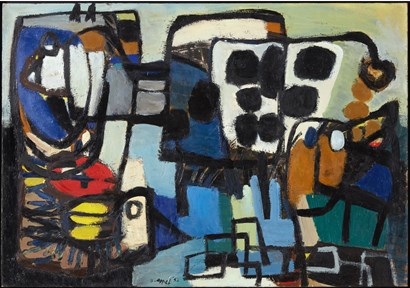
Guy Pieters Gallery
karel appel
Karel Appel (Amsterdam 1921-2006 Zurich) Polderkoe, 1952 Oil on canvas 82 x 116 cm This work is registered in the archives of the Karel Appel estate Provenance: Martha Jackson Gallery, New York; private collection, Belgium; Galerie Krikhaar, Amsterdam; private collection, Brussels
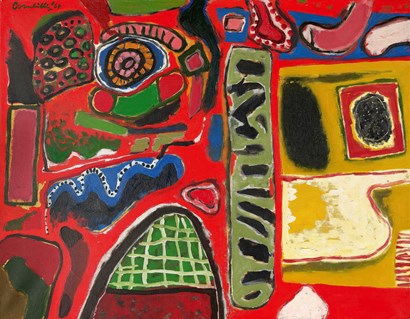
De Zutter Art Gallery
corneille
Corneille (Liège 1922-2010 Auvers-sur-Oise) Le rouge iténéraire de l'été, 1964 Oil on canvas 73 x 92 cm Provenance: Galerie Delta, Rotterdam; kunsthandel Lambert Tegenbosch, Heusden; collection Dr. Johan B.W. Polak (1928-1992), Amsterdam; Christie's, Amsterdam, 10 December 1992, lot n° 325; private collection, Switzerland Literature: Catalogue Galerie Cimaise Bonaparte (Patrick d'Elme and Daniel Templon), 1967, Paris Exhibition: Galerie Cimaise Bonaparte (Patrick d'Elme and Daniel Templon), 1967, Paris

Almine Rech
hans op de beeck
Hans Op de Beeck (Turnhout, 1969) Crow, 2025 MDF, metal, polyamide, coating and bronze H 160 x W 80 x D 56 cm - Weight 39 kg Edition of 5 plus 2 APs Provenance: Studio of the Artist 'Crow' is a kinetic sculpture of a life-size flying crow. Powered by a mechanical system, the crow's flight creates the illusion of forward motion, although it remains suspended in place. 'Crow' evokes the world of fables and classic animated films, in which animals take on human traits. The work also alludes to the age-old tradition of mechanically animated figures, whose repetitive, joyless movements often inspire a quiet melancholy. At the same time, it is striking how lifelike and fluid such mechanically simplified movements can sometimes appear.
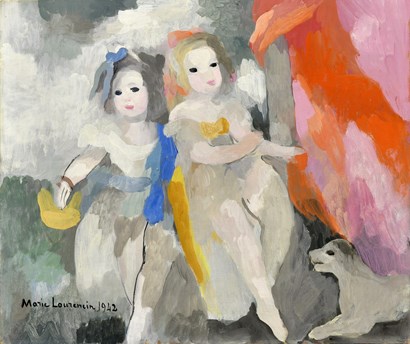
Galerie Taménaga
marie laurencin
Marie Laurencin (Paris, 1883-1956) Deux fillettes et chien, 1942 Oil on canvas 46 x 55 cm Signed and dated lower left 'Marie Laurencin 1942' Provenance: private collection Literature: Beaux-Arts, Paris, 24-30 July 1952; Daniel Marchesseau, Marie Laurencin, Catalogue raisonné de l'œuvre peint, Tokyo: Marie Laurencin Museum, 1986, vol. I, n° 804, repr. p. 327
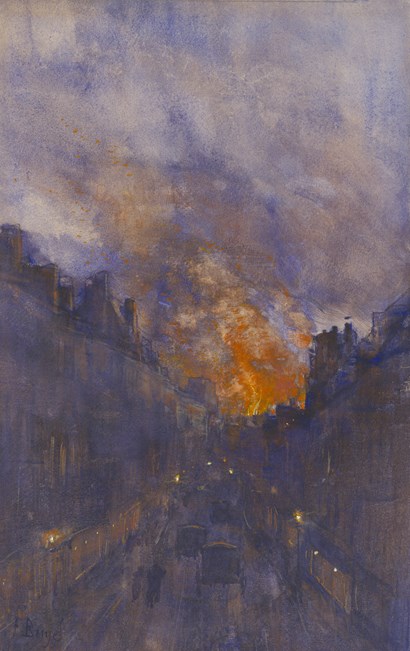
Thomas Deprez Fine Arts
franz binjé
Franz Binjé (Liège 1835-1900 Brussels) Le feu, circa 1894 Watercolour and gouache on paper 42 x 27.5 cm Signed l.l.: 'F. Binjé'. Provenance: private collection, Belgium Exhibitions: Exposition Universelle des Beaux-Arts, section Société Royale belge des Aquarellistes, Antwerp, World Fair, 1894, cat. nr. 699, as: 'Le feu'; Internationale Kunst-Ausstellung, Berlin, World Fair, 1896, Gemälde cat. nr. 228, as: 'Das Feuer. Aquarell.'
_GeorgesJEANCLOS_T638915587955330883.tif?width=410&height=2000&qlt=90&scale=both&mode=max&format=jpeg)
Galerie Capazza
georges jeanclos
Georges Jeanclos (Paris, 1933-1997) Kamakura, 1991 Terracotta H 30 x W 45 x D 40 cm Provenance: the artist's studio Exhibition: Georges Jeanclos, Élévation, Abbaye Royale de Fontevraud, 25 November 2023-4 March 2024 The Kamakura series was inspired by Georges Jeanclos' trip to Japan, which took him to the country's ancient medieval capital, home to the oldest Japanese Zen gardens. Jeanclos was deeply moved by the beauty and serenity that emanated from these meditative and contemplative landscapes. Upon his return to Paris, these characters were born, sculptures of resilience, ‘monks in meditation, spectators of their inner gardens’ (Tzvetan Todorov). Georges Jeanclos (1933–1997) was one of the great French sculptors of the 20th century. His work was inspired by the traumatic events of the Second World War. To escape the roundups threatening Jews in France, his family had to hide in the woods; he himself, aged around ten, learned to live with the danger of death. In the aftermath of the Liberation, he saw the bodies of former collaborators hanging from lampposts; shortly afterwards, he discovered the skeletal beings who had survived the camps. Decades later, Jeanclos would respond to this formative experience: not by withdrawing into his own experiences, but by opening himself up to the universal, listening to all suffering, past and present; not by depicting horror, but by finding within himself the strength to create beauty. Jeanclos transforms the earth he works with into thin sheets, which he uses to form figures with similar faces, both children and adults, men and women. They are sleepers lying under a sheet of earth; beings enclosed in urns stamped with Hebrew letters taken from prayers for the dead; figures loaded onto boats bound for the other world; kamakuras, meditating monks. Later, he would add Pietàs, Adam and Eve in love, couples brushing against or embracing each other. Jeanclos' images reveal both the insignificance of our person and the indomitable strength of our love; by their mere existence, they help us to live. Tzvetan Todorov
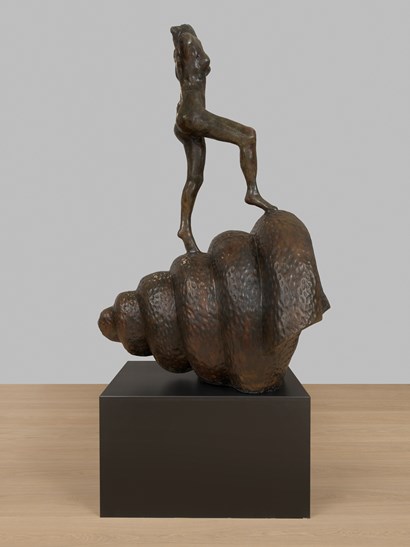
CKS Gallery
Salvador Dalí (Spain, Figueras 1904-1989) Nude ascending the staircase, 1973 Brown patina bronze sculpture H 212 × W 139 × D 117 cm - Height with the base: 297 cm Signed & numbered 'Dalí 2/8', Foundry mark 'Fratelli Bonvicini, Italie' on the shell Certificate of authenticity by M. Robert Descharnes and listed in the Descharnes Archives under the n° 0-264 Provenance: private collection
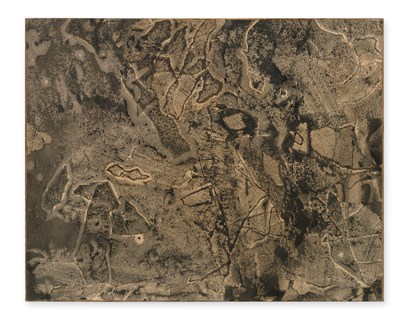
Repetto Gallery
jean dubuffet
Jean Dubuffet (Le Havre 1901-1985 Paris) Topographie, January 1959 Oil on paper collage applied on paper [assemblage d’empreintes (huile noire)] 47 x 59 cm Certificate of authenticity by Galerie de l’Ile-de-France, Paris Provenance: Galerie de l’Ile-de-France, Paris; private collection, Italy Literature: Max Loreau (Ed.), Catalogue des travaux de Jean Dubuffet. Fascicule XIX : Célébration du sol II, texturologies, topographies, Weber éditeur, Paris, n° 173
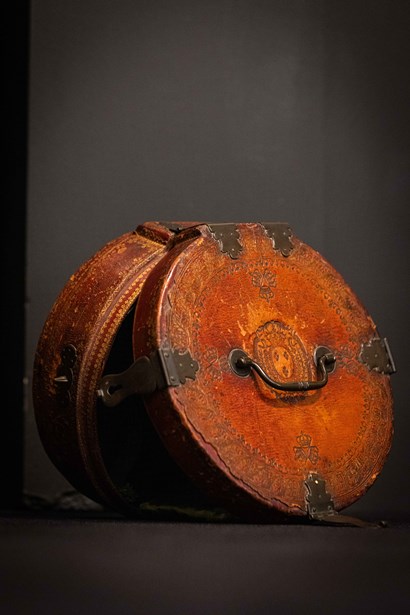
Art et Patrimoine - Laurence Lenne
Transport case, for Louis XV at the Château de Versailles France, made between 1745-1749 Gilt-tooled leather, copper hinges H 11 cm - Ø 26.5 cm Provenance: Louis XV in Versailles Carrying and protective case for a silver porringer. The lid of the case is decorated with the coat of arms of Louis XV and the three facing crowns of the Château de Versailles, both gilt-tooled. All copper hinges are stamped with the crowned 'C' mark. The case was made between March 5th, 1745 and February 4th, 1749.
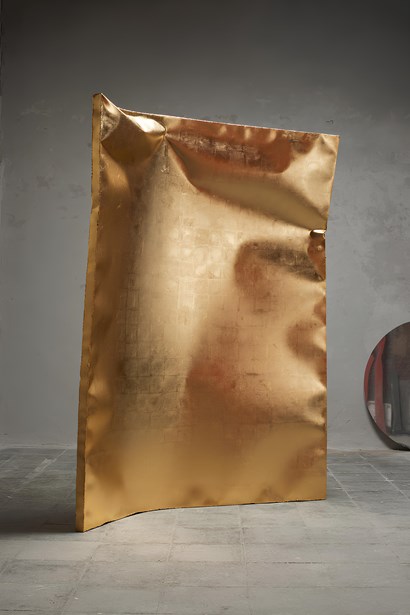
Objects With Narratives
ben storms
Ben Storms (Ghent, 1983) Crushed room divider, 2024 H 195 x W 160 x D 45 cm Stainless steel, gold leaf Provenance: the artist's studio The purpose of this volume is deliberately ambiguous. The object is primarily sculptural, a monumental entity that redefines a space. Yet in doing so, it also reveals its potential function. In the way that the work structures a space, it turns out to be a divider that demarcates and defines compartments or areas. The starting point for this room divider and sculpture is essentially a provisional form. A composition of several sheets of metal welded together with air in between - think of Ben’s In Hale series, but in a different sense. The actual form is then created by subjecting this makeshift composition to external forces, crushing the surfaces until the volume finds its current state.

d'Arschot & Cie
Perfume bottle and case Germany, circa 1620 Anonymous silversmith Chased, engraved, and partially gilded silver. Case in boiled leather. H 9 cm – Weight: 58 g This elegant perfume bottle stands out for the exceptional preservation of its original boiled leather case, a testament to the care taken in protecting and transporting such precious objects in the 17th century. The bottle features a finely engraved vegetal motif enlivened with small exotic birds, typical of the work of silversmiths from southern Germany during the first third of the century. At a time when the distillation of essences was still in its infancy, such bottles accompanied the daily life of the elite, allowing the frequent application of fleeting perfumes. This model, fitted with a screw cap ensuring perfect sealing, illustrates both the practical function and the symbolic value of perfume as a marker of social distinction.
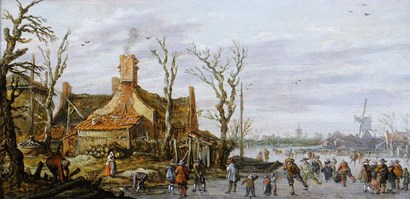
Floris van Wanroij Fine Art
jan josefsz. van goyen
Jan Josefsz. van Goyen (Leiden 1596-1656 The Hague) Winter landscape with skaters, elegant figures and kolf players on the ice in a village Oil on panel 13.6 x 26.8 cm Signed and indistinctly dated lower left ‘I.V. GOYEN. 162.‘ Provenance: anonymous sale, Drouot, Paris, 21 March 1874, lot 23 (Frs. 510), erroneously as a pendant to the consecutive lot; collection Comte de Camondo, Galerie Georges Petit, Paris, 1 February 1893, Lot 6 (Frs. 1.700), were acquired by W. Gretor; anonymous sale, Drouot, Paris, 18 February 1895, Lot 13 (Frs. 750), were acquired by Lange; collection G. Forbes, London (according to Dayot and Hofstede de Groot); sale Jules Cronier, Galerie Georges Petit, Paris, 11 March 1908, Lot 88 (Frs. 1,200); with Kleinberger, Paris; collection Eugène Max, Paris, from 1911 to 1927; Grange, Paris; private collection, Paris, from 1965; anonymous sale, Sotheby’s, London, 1 March 1992, lot 36 (£ 101,200); John Mitchell, London, from 1993; anonymous sale, Christie’s, Amsterdam, 20 November 2012, lot nr. 68 (211.000 Euro); Johnny van Haeften Ltd., London, from 2014 (ref. VP4577), acquired from the previous owner; private collection, The Netherlands Literature: Dayot, A. (1911), Grands & petits maîtres hollandais, exhibition publication, Paris, n° 42; Martin, W. (1918), Alt-Holländische Bilder, Berlin, p. 51, fig. 25; Hofstede de Groot, C. (1927), A catalogue raisonné of the works of the most eminent Dutch painters of the seventeenth century, London, Vol. VIII, p. 294, n° 1170; Beck, H.-U. (1972), Jan van Goyen 1597-1656, Amsterdam, Vol. II, p. 46, n° 88 (illustrated, erroneously as a pendant to n° 244) Exhibitions: Paris, Salle du Jeu de Paume, Grands & petits maîtres hollandais, 28 April-10 July 1911, n° 40 bis; TEFAF Maastricht, 2014
_MekhitarGarabedian_T638925902664298349.jpg?width=410&height=2000&qlt=90&scale=both&mode=max&format=jpeg)
N. Vrouyr
mekhitar garabedian
Mekhitar Garabedian (Syria, Aleppo 1977) I copied this in a hurry and wrote in large letters (carpet) Pile: wool and silk, warp and weft: cotton 120 x 120 cm Provenance: handmade in Nepal For the design of this carpet, and the edges of the image in particular, Mekhitar Garabedian has reinterpreted Armenian medieval miniatures. The decorative patterns were the monks’ preferred place to improvise and deviate from the norm. By appropriating various visual and textual sources, Garabedian explores the fragility of heritage. Biography Deploying a variety of media such as drawing, video, photography and installation, many of Mekhitar Garabedian’s works draw from his experience as an immigrant and play on the humour and poetic qualities he finds between languages, cultures and histories. Just as his personal diasporic history is layered, his work echoes with a multiplicity of references to literature, music, philosophy and visual arts. Mekhitar Garabedian (°1977) was born in Aleppo and lives and works in Antwerp. In 2022, he was commissioned by Middelheimmuseum/Kunst in de Stad to create a public sculpture in the Antwerp Stadspark. Previously he had solo exhibitions at BOZAR in Brussels, S.M.A.K. in Ghent, Beursschouwburg in Brussels, BE-Part in Waregem and KIOSK in Ghent. In 2015 he was invited to present several works at the Venice Biennale in the Armenian pavilion, which was awarded with the Golden Lion. Garabedian participated in group exhibitions that were held at the New Museum in New York, Hamburger Kunsthalle, WIELS in Brussels, 5th Thessaloniki Biennial, Marta Herford, Villa Empain in Brussels, Gulbenkian Museum in Lisbon, Argos in Brussels, Haifa Biennial, BAM in Mons, M HKA in Antwerp, Drawing Room in London, Museum M in Leuven and Kunsthaus in Dresden, amongst many others.





 NEWSLETTER
NEWSLETTER



